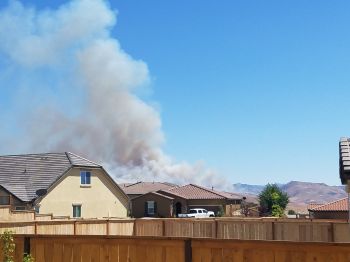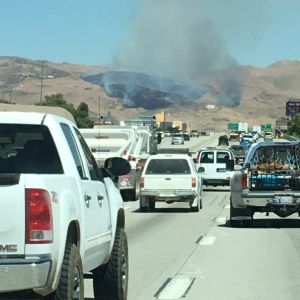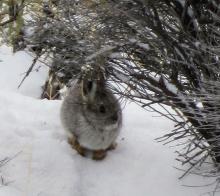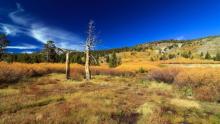By Tracy Visher, Thursday, July 7, 2016 at 11:30 AM
I headed out of the office yesterday afternoon for an errand in Spanish Springs. As I got on the freeway in Reno, I saw the plume of smoke from the Virginia Range. At first I thought it was in Hidden Valley, but the curve of the freeway soon showed me it was up behind the Northern Nevada Medical Center, to the left of the big “S” on the hill in Sparks.
This is it, I thought. Finally a fire of a scale and visibility that will be the “real” start of our summer wildfire season. As I drove and watched the fire race up to the ridge line, I also thought, this is what we need, a local fire spectacular enough for all to see, to be reminded and to be frightened. Somehow the recent Hawken II fire didn’t quite do that for many, other than the responders and the residents at the bottom of that fire’s footprint. It moved uphill and was out of sight and mind all too quickly.
This may sound mean-spirited but I have good cause to think so. As an old timer fireman told me last year, “The further we are from one disaster, the closer we are to the next one.” Tucking frightening experiences into the back of our consciousness is part of the human means of survival. Complacency is a different thing all together.
As we learned with the Caughlin fire in November of 2011 and the Washoe Drive fire in January of 2012, we don’t only have a summer fire season in the Truckee Meadows. With years of drought under our collective belts, fire in Northern Nevada is a 12 month season. So what have we learned? Has our behavior as individual home owners been altered by what we have seen?
There is a term you may not have heard, the slang for which is WUI or Wildland Urban Interface. This describes the intersection between open space and our urban, residential footprint. While its existence is obvious up in Galena or West Washoe Valley where houses sit in the trees, it is also the kind of space burning in Sparks today. It can be grassland as well, anywhere that homes and open space co-exist. This can create some confusion with regard to responsibility for maintenance, preparedness and fire treatment. In Nevada, over 80% of the land is public. These public lands include national parks, forests, wildlife refuges, monuments, and wilderness.
For the past 100 years, the national agency strategy for fire suppression has focused on putting fires out as soon as they start. This has become an ever larger issue with the incursion of human residences moving out into more and more WUI. Because of human intervention, fires were not allowed to take any sort of “normal course”. This has resulted in monumental stands of undergrowth and over growth of trees and shrubs. Add drought to the mix and trees stress, insects move in and we have thousands of acres of dead trees to add to this fuel load. All of which have given us the Mega Fires of recent years in the West.
In the past few years, agency heads in Washington DC have been meeting to change this paradigm. A new fire-fighting strategy has been born, called the National Cohesive Wildland Fire Management Strategy. One of the challenges our agency fire fighters have faced is the fact that the costs to put out these mega fires (suppression) are so high that there is little funding left to go into restoration and landscape resilience. To illustrate, in 1985 the combined federal fire agencies spent $293,943,000 on fire suppression. In 2015, that cost was $2,130,543,000, the lion’s share in the Western US.
Nevada Land Trust has spent the better part of the past year meeting with agency partners and local Living With Fire members, learning what the Cohesive Strategy was and how we might facilitate its implementation in Nevada. The strategy has 3 tenets to it: 1) Restore and maintain landscapes, 2) Fire-adapted communities, and 3) Wildfire response (if you’d like to read a summary of the whole plan, go here: National Cohesive Wildland Fire Management Plan.) At this juncture, you might wonder why we care. We are a land conservation and protection non-profit organization, isn’t this mission scope creep? NO! There is every reason for us to care! What happens in a fire? If your property is at risk, you are thinking about saving your kids, pets, family mementos and things you feel you can’t replace. We are thinking about watershed and wildlife destruction. That is all habitat we are committed to protecting!
Starting last September, NLT was fortunate to be invited to participate in the Fire Adapted Communities Learning Network across the nation, whose members are striving to build Fire Adapted Communities in their areas. As you will recall, this is one of the Cohesive Strategy tenets, but what does it mean? Since 2009, in Washoe County, the Living With Fire program has been working to educate our residents about their role in this equation. The US Forest Service defines a Fire Adapted Community as: "A knowledgeable and engaged community in which the awareness and actions of residents regarding infrastructure, buildings, landscaping, and the surrounding ecosystem lessens the need for extensive protection actions and enables the community to safely accept fire as a part of the surrounding landscape." At the end of the day, residents in the WUI should understand:
1. The role of fire on the surrounding landscape
2. Fire authorities may not save all homes
3. Community mitigation actions reduce the impacts of wildfire
Did you know that there are actually some Fire Adapted Communities in existence here in Washoe County? Did you know that there is a Nevada Network of Fire Adapted Communities? Neither did we until last year!
So back to the question of how and why Nevada Land Trust? Some of the key success criteria for a Fire Adapted “NETWORK” are connectivity, education, training, support with writing prescriptions for residents to perform fuels work on their property and help finding grant funding to pay for it. If residents are “taught to fish” vs being given a fish, they can learn to better protect their property from wildfire damage. It takes a village! Neighbor joining neighbor to create a defensible neighborhood.

Maybe you live down the block or even miles from the houses you think of as in the WUI, who ARE performing fuels reduction (a term you should also know). Not your problem? Did you know the furthest an ember from a fire has been known to travel is 14 miles!? If you don’t think you can relate to this, check out this ember burn test video. It was created to test the flammability of different building materials and different vegetation conditions around a typical residential home. When I saw it, I went home and pruned and cleared like a mad woman! I have seen photos where three houses in a row experienced a fire nearby. The left and right, untouched because they attended to their property, the middle, half gone because it didn’t.
Nevada Land Trust is looking at partnering with Living With Fire to begin a Washoe County pilot program to see if we can help close the circle of support for Washoe County neighborhoods who are interested in joining in the wildfire fight. The work you do at home can protect your property, but it also helps to slow the spread of wildfire through our open spaces, watershed and habitat. Our state and federal fire agencies are working with us to figure out how we can work together to make this happen. Remember the cold hard fact is: Fire isn’t an IF, it’s a WHEN! Stay tuned for updates as we move forward!


